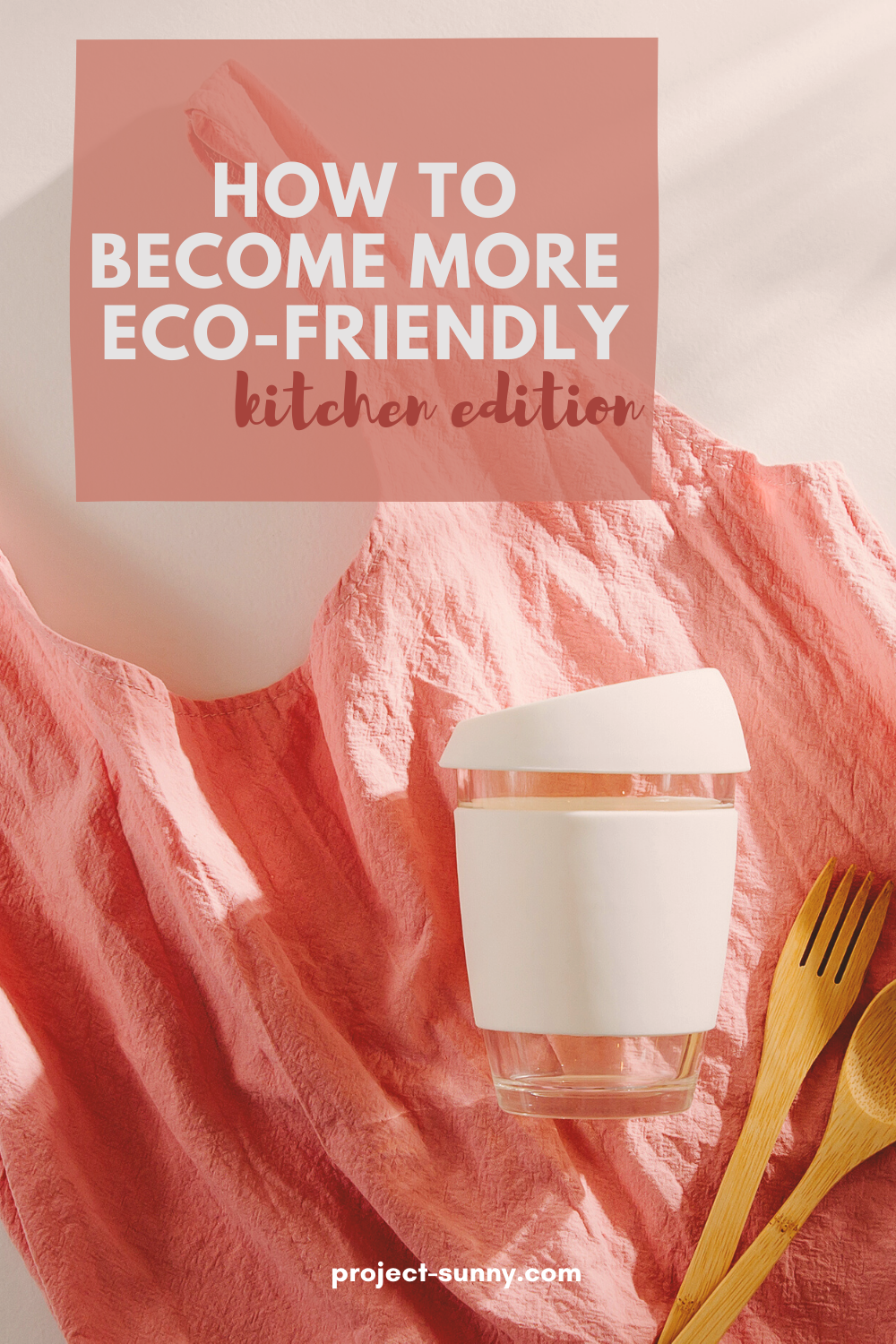10 Ways To Build An Eco-Friendly Kitchen
I’ve been meaning to put together a post on how to get started with your eco-friendly journey for a while now, but I wanted to make sure it came off in a way that doesn’t seem daunting or overwhelming. This lifestyle can be fun and rewarding!
There’s so much I want to share and I felt like it might be better to break up the posts into categories rather than one giant post. So that’s what we’re gonna do!
Today’s post will focus on creating an Eco-Friendly Kitchen! Ohhhhh yeah. My favorite place :)
We’ll probably dive deep, but just remember that this lifestyle is not about perfection. It’s about taking small steps daily, in the right direction. None of us are perfect, and we will go much further with lots of people taking action (no matter how small) then we would if nobody took any action at all. So let’s do this!
*This post contains affiliate links. That means that if you make a purchase after clicking on a link I may earn a small commission at no extra cost to you.*
10 WAYS TO BUILD AN ECO-FRIENDLY KITCHEN:
1) Invest in Reusable Grocery Bags and Produce Bags
This is a widely known tip by now, but choose to bring your own bags to the grocery store. Or any store for that matter! This is such a simple way to avoid using plastic bags. I also recommend investing in reusable produce bags. Plastic grocery bags and produce bags are usually only used from the time you leave the grocery store until the time you get home. That is such a waste given the repercussions of plastic bags.
I love collecting cute totes (obsessed with these bags) to take with me to the store. One of my favorite things to do is find them in thrift shops! I have about 4-5 adorable straw bags that I’ve found at Goodwill for less than $5 each. They are cute and beachy and they make me really happy! These are the produce bags I use and I absolutely love them (and they come with bonus reusable straws).
Tip: leave some bags in the trunk of your car so that you always have them when it’s time to go to the store. If you do forget your bags (it happens), don’t be afraid to speak up and tell the cashier than you prefer paper bags over plastic!
2) Be Mindful of Food Waste
I recently read that 40% of food in the United States is wasted every single year. Isn’t that heartbreaking? No doubt wasting food sucks. It’s a waste of money and it makes us feel guilty. But did you know that food waste is actually really bad for the environment?
Think about everything a piece of food goes through before it lands in your shopping cart. It has to be grown, harvested, processed, packaged, transported, stocked, and sold. As you can imagine, that requires a lot of resources (land, water, emissions, plastic, etc). When food gets thrown out, all of those resources are wasted. Knowing this should inspire you to be a more conscious buyer.
To be fair, it isn’t just us (the consumer) wasting food. It happens at every level of the food production process. This topic truly deserves a post of its own, but today we’re focusing on how we can do our part. And our part in fighting this is to not over-buy at the grocery store and not let the food in our kitchen go to waste.
I always suggest taking time before going to the grocery store to sit down and make a list of what you actually need. Don’t get ambitious, be realistic. What will you and your family actually eat for the week? When you go to the grocery store, stick to the list. Don’t impulse buy. Remember you can always come back to the grocery store if you need to.
If you notice fresh produce starting to turn, or you know you won’t be able to use it before it goes bad, store it in your freezer and use it later in soups, smoothies, stir fry, etc.
3) Ditch Plastic Water Bottles
Guys, this is such a simple swap! Aside from dire situations, plastic water bottles are completely unnecessary.
If you don’t have quality water at home, get a filtered pitcher. And if you need water to-go, get yourself a reusable water bottle - this is the one I use. There really is no excuse to use plastic water bottles, but especially not at home.
Water bottles may technically be recyclable. But research shows that 91% of plastics are never recycled. So this is not a viable solution. The best solution is not to use them in the first place. Also, studies have also shown that chemicals from the plastic can seep into your water, having negative effects on your health (yikes). Ditch them.
4) Sustainable Food Storage
Invest in long-lasting, reusable food storage.
For example glass tupperware, reusable ziplocks, and beeswax food wrap.
Also, consider saving old jars and containers that your food comes in to use as storage in the kitchen. For example, pasta jars are an excellent way to store food.
5) Buy in Bulk
Look online for a “buy in bulk” store in your community and shop there for things such as oatmeal, nuts, beans, and grains. You can bring and fill your own jars. This reduces plastic waste and usually saves you money, too.
You may also be able to find a store than has refillable/dispensable soap, laundry detergent, etc.
6) Switch Out Your Dish Washing Tools
Did you know it’s actually better to let the dishwasher clean your dishes rather than doing it by hand? Research shows it saves more energy and more water. It’s also best to wait until the washer is completely full before running it.
If this isn’t an option for you, or for dishware that is too delicate for the washer, use sustainable tools. Plastic sponges and brushes get switched out often and create a lot of waste. Instead, opt for brushes with wooden handles, non-plastic bristles, and biodegradable sponges. Here is a great starter-pack for that! Also, get some plastic-free dish soap like this genius dishwashing block.
p.s - if you already have plastic dish tools, keep using those until they completely wear out!
7) Use Cloth Towels Instead of Paper Towels
This one was actually difficult for me. But it is possible to make the switch or to cut back greatly on paper towel use.
Invest in a pack of dish towels or tea towels that you can use for cleaning and spills. And instead of using paper towels as your napkin during mealtime, get a set of cute washable napkins. Be patient with yourself on this one, I know it’s tough.
8) Don’t Use Paper or Plastic Dishware
It’s super tempting to use paper plates and plastic utensils at mealtime. We’re all busy and this requires less cleanup. But it is so, SO wasteful and unnecessary. Not only does it produce a lot more trash, but it’s also a waste of money.
Do your part and just use your regular old dishes. It’s worth it.
9) Make Your Own Non-Toxic Kitchen Cleaner
Store-bought cleaners are not only toxic, but they come in plastic bottles. Consider making your own cleaner instead. There are tons of DIY cleaning recipes online or you can use my All-Purpose Citrus Cleaner recipe, which I love and use for everything in my kitchen and bathroom.
It’s also much cheaper to make it yourself. Whoop.
10) Be a Conscious Coffee Drinker
Unfortunately, making coffee comes with a lot of opportunities for waste.
Single-use coffee pods are so wasteful. If you still use them - please, please, please consider a different alternative. Just one person can use over 300+ coffee pods a year. So. Much. Waste.
The most eco-friendly way to brew coffee is with a coffee press. If you use a machine, invest in a reusable coffee filter. You can also compost your coffee grounds or use them to make a DIY body scrub!
Tip: when out and about, bring a reusable cup to use at the coffee shop. This will save you from using any single-use items.
Alrighty, friends. That’s it for today. I hope this post is helpful to you. If you have any tips you’d like to add, please leave them in the comments below - I’d love to hear them! Once again, please be patient with yourself on your eco-friendly journey! It’s a process and nobody is perfect. We are all in this together :)
Chat soon, Cort.






